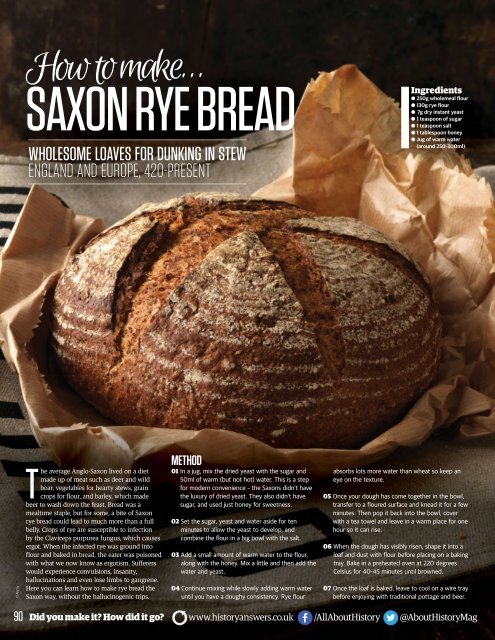All About - History - Hitler Versus Stain
All About History offers a energizing and entertaining alternative to the academic style of existing titles. The key focus of All About History is to tell the wonderful, fascinating and engrossing stories that make up the world’s history.
All About History offers a energizing and entertaining alternative to the academic style of existing titles. The key focus of All About History is to tell the wonderful, fascinating and engrossing stories that make up the world’s history.
Create successful ePaper yourself
Turn your PDF publications into a flip-book with our unique Google optimized e-Paper software.
How to make…<br />
SAXON RYE BREAD<br />
WHOLESOME LOAVES FOR DUNKING IN STEW<br />
ENGLAND AND EUROPE, 420-PRESENT<br />
Ingredients<br />
250g wholemeal flour<br />
130g rye flour<br />
7g dry instant yeast<br />
1 teaspoon of sugar<br />
1 teaspoon salt<br />
1 tablespoon honey<br />
Jug of warm water<br />
(around 250-300ml)<br />
© Alamy<br />
90<br />
The average Anglo-Saxon lived on a diet<br />
made up of meat such as deer and wild<br />
boar, vegetables for hearty stews, grain<br />
crops for flour, and barley, which made<br />
beer to wash down the feast. Bread was a<br />
mealtime staple, but for some, a bite of Saxon<br />
rye bread could lead to much more than a full<br />
belly. Crops of rye are susceptible to infection<br />
by the Claviceps purpurea fungus, which causes<br />
ergot. When the infected rye was ground into<br />
flour and baked in bread, the eater was poisoned<br />
with what we now know as ergotism. Sufferers<br />
would experience convulsions, insanity,<br />
hallucinations and even lose limbs to gangrene.<br />
Here you can learn how to make rye bread the<br />
Saxon way, without the hallucinogenic trips.<br />
METHOD<br />
01 In a jug, mix the dried yeast with the sugar and<br />
50ml of warm (but not hot) water. This is a step<br />
for modern convenience – the Saxons didn’t have<br />
the luxury of dried yeast. They also didn’t have<br />
sugar, and used just honey for sweetness.<br />
02 Set the sugar, yeast and water aside for ten<br />
minutes to allow the yeast to develop, and<br />
combine the flour in a big bowl with the salt.<br />
03 Add a small amount of warm water to the flour,<br />
along with the honey. Mix a little and then add the<br />
water and yeast.<br />
04 Continue mixing while slowly adding warm water<br />
until you have a doughy consistency. Rye flour<br />
absorbs lots more water than wheat so keep an<br />
eye on the texture.<br />
05 Once your dough has come together in the bowl,<br />
transfer to a floured surface and knead it for a few<br />
minutes. Then pop it back into the bowl, cover<br />
with a tea towel and leave in a warm place for one<br />
hour so it can rise.<br />
06 When the dough has visibly risen, shape it into a<br />
loaf and dust with flour before placing on a baking<br />
tray. Bake in a preheated oven at 220 degrees<br />
Celsius for 40-45 minutes until browned.<br />
07 Once the loaf is baked, leave to cool on a wire tray<br />
before enjoying with traditional pottage and beer.<br />
Did you make it? How did it go? www.historyanswers.co.uk /<strong>All</strong><strong>About</strong><strong>History</strong> @<strong>About</strong><strong>History</strong>Mag


















